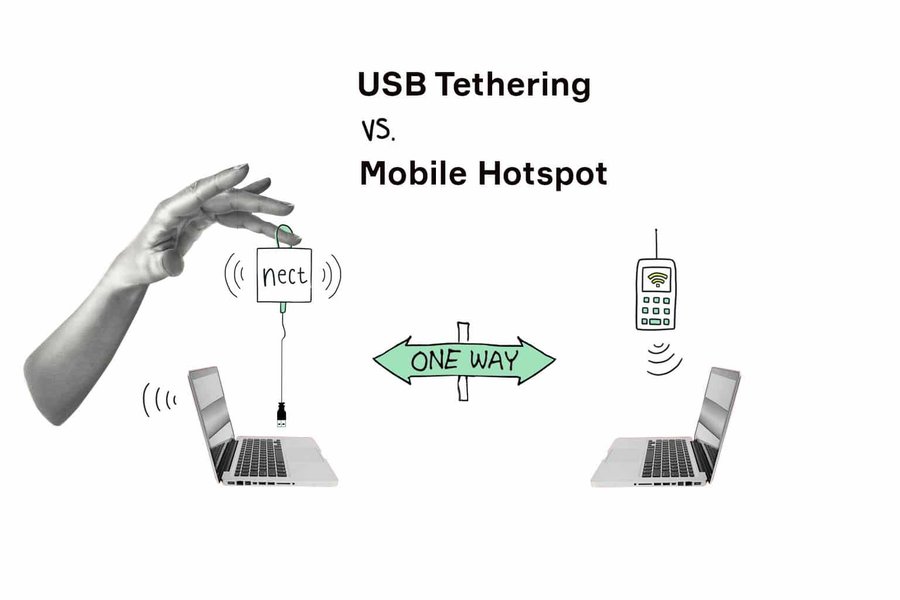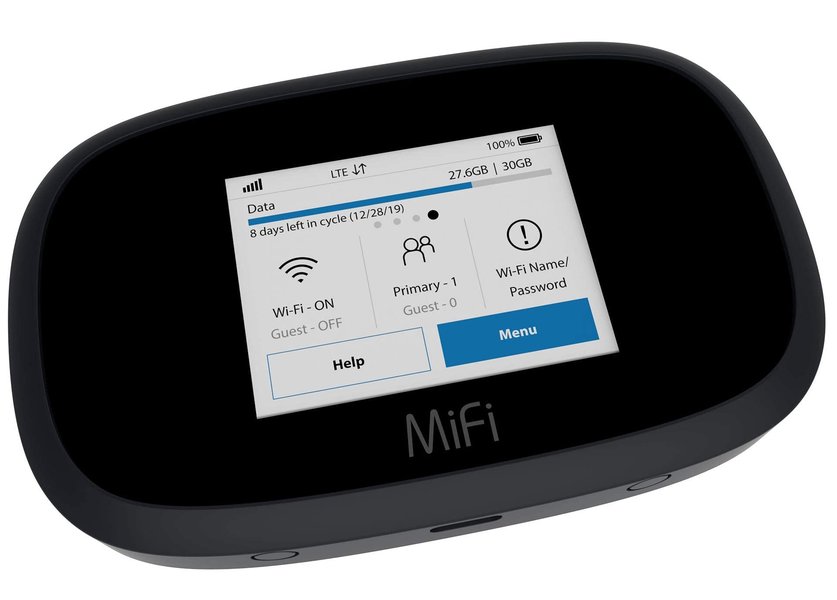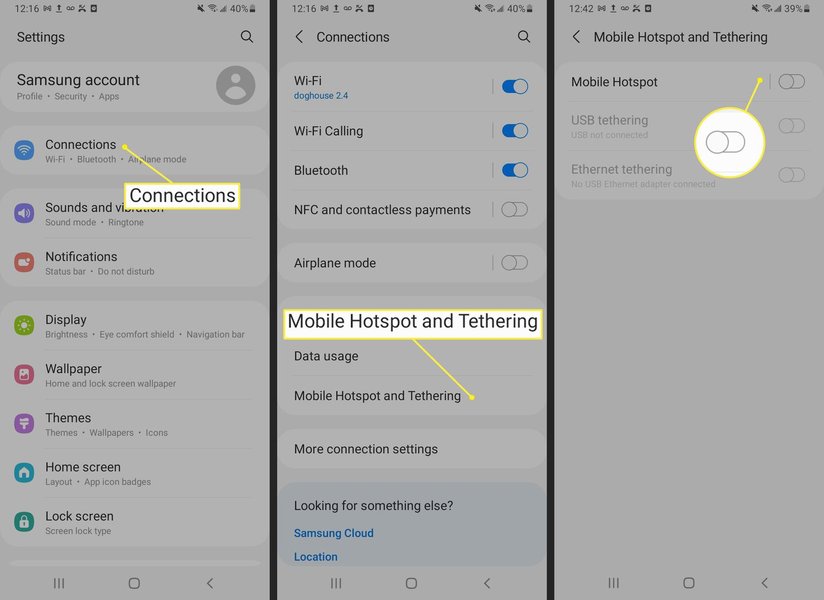
Understanding Tethering: A Comprehensive Guide
Exploring the ins and outs of tethering, its benefits, and how to use it effectively.
Key Highlights of Tethering
- Enhanced Internet Speed: USB tethering generally provides faster internet speeds compared to Wi-Fi hotspots due to a direct, wired connection.
- Improved Battery Health: USB tethering is more power-efficient, which can help preserve your phone's battery life compared to using a mobile hotspot.
- Versatile Connectivity: Tethering allows you to share your mobile data connection with various devices, including laptops, tablets, and even routers.
What is Tethering?
Tethering refers to sharing your mobile device's internet connection with other devices. This can be achieved through various methods, including USB, Wi-Fi (mobile hotspot), and Bluetooth. Tethering is useful when you need internet access on a device that doesn't have its own internet connection or when Wi-Fi is unavailable.
Methods of Tethering
There are several ways to tether your devices, each with its advantages and disadvantages.
- USB Tethering: Connecting your phone to a computer via a USB cable.
- Wi-Fi Hotspot: Turning your phone into a Wi-Fi router, allowing other devices to connect wirelessly.
- Bluetooth Tethering: Sharing your phone's internet connection via Bluetooth.
USB Tethering vs. Mobile Hotspot
When deciding between USB tethering and using a mobile hotspot, consider several factors such as speed, battery life, and security.
Speed and Performance
USB tethering generally offers faster internet speeds compared to Wi-Fi hotspots. This is because USB provides a direct, wired connection, reducing latency and improving data transfer rates. The actual speed depends on the USB version (e.g., USB 2.0, USB 3.0) and your phone's support for these standards.
Battery Consumption
USB tethering is more power-efficient than using a mobile hotspot. When tethering via USB, your phone can also charge simultaneously, maintaining battery health. In contrast, a mobile hotspot consumes more battery power because it requires the phone to act as a Wi-Fi router, constantly transmitting signals.
Security Considerations
USB tethering is generally more secure because it involves a direct connection between devices, reducing the risk of unauthorized access. Wi-Fi hotspots, while convenient, can be less secure if not properly configured with a strong password.
Ease of Use
Setting up a mobile hotspot is typically straightforward: you enable the hotspot feature on your phone, and other devices can connect to it like any other Wi-Fi network. USB tethering requires a USB cable and may involve installing drivers on your computer, although most modern operating systems support USB tethering natively.
How to Set Up Tethering
Setting Up USB Tethering on Android
- Connect your Android phone to your computer using a USB cable.
- Go to Settings on your phone.
- Navigate to Network & Internet, then Hotspot & Tethering. On some Samsung devices, this might be under Settings, then Connections, then Mobile Hotspot and Tethering.
- Enable USB Tethering.
- Your computer should recognize the connection and configure it automatically.
Setting Up a Wi-Fi Hotspot on Android
- Go to Settings on your phone.
- Tap Network & Internet, then Hotspot & Tethering.
- Select Wi-Fi Hotspot.
- Configure the hotspot name, security type, and password.
- Turn on the Wi-Fi Hotspot.
- On your other device, connect to the Wi-Fi network using the name and password you set.
Advanced Tethering Uses
Tethering to a Router
You can even tether your phone's internet connection to a router to share it with multiple devices simultaneously. This setup typically involves connecting your phone to the router via USB and configuring the router to use the USB connection as its internet source. Some routers support this feature directly, while others may require custom firmware or additional configuration.
Combining Wi-Fi and USB Tethering
For increased reliability and bandwidth, you can combine your Wi-Fi connection with a USB-tethered Android phone's cellular data. This involves configuring your computer to use both connections simultaneously, providing a more robust and faster internet experience.
Pros and Cons of Tethering
Tethering offers a convenient way to share your mobile internet connection, but it's essential to weigh the advantages and disadvantages.
Advantages
- Convenience: Provides internet access when no Wi-Fi is available.
- Cost-Effective: Uses your existing mobile data plan.
- Faster Speeds (USB): USB tethering often provides faster speeds than Wi-Fi.
- Secure Connection (USB): More secure than public Wi-Fi hotspots.
Disadvantages
-
Data Usage: Can quickly deplete your mobile data allowance.
-
Battery Drain (Hotspot): Using a mobile hotspot can drain your phone's battery quickly.
-
Carrier Restrictions: Some carriers may charge extra for tethering or have restrictions on data usage.
-
Performance Limitations: Tethering speed and performance depend on your mobile network and device capabilities.
Tethering in Various Scenarios
Travel
Tethering is particularly useful when traveling and needing internet access on your laptop or tablet in areas without reliable Wi-Fi. Whether you're in a hotel, airport, or remote location, tethering can provide a convenient and secure way to stay connected.
Emergencies
In emergency situations, tethering can be a lifeline for accessing critical information or communicating with others. If your primary internet connection fails, you can use your phone's data connection to keep your devices online.
Work From Home
For those who work remotely, tethering can serve as a backup internet connection in case of a home internet outage. This ensures you can continue working without interruption.
Gaming
While not ideal for all types of games due to potential latency issues, tethering can provide a temporary solution for online gaming when no other internet connection is available. USB tethering is generally preferred over Wi-Fi for gaming due to its lower latency and more stable connection.
Tethering: A Comparison Table
Here is a comparison table highlighting the key differences between USB tethering and using a mobile hotspot:
| Feature | USB Tethering | Mobile Hotspot |
|---|---|---|
| Speed | Faster (direct connection) | Slower (wireless) |
| Battery Consumption | Lower (charges while in use) | Higher (drains battery faster) |
| Security | More Secure (wired connection) | Less Secure (Wi-Fi network) |
| Ease of Use | Requires USB cable; may need drivers | Easy to set up; no cable needed |
| Number of devices supported | Typically one device | Multiple devices |
Visualizing Tethering Setups
Here's a look at various tethering setups and devices that make tethering possible.

USB tethering is shown to be faster than using a mobile hotspot.

The Inseego MiFi 8000 4G LTE Global Mobile Hotspot is a mobile hotspot device, for creating a portable Wi-Fi network wherever you are.

USB tethering to a Windows PC requires you to connect your phone to the PC and then enable USB tethering in the Android settings.
Demonstrating USB Tethering
Watch this video to see how to easily connect your Android phone to your laptop for high-speed mobile internet access using USB tethering. It provides a step-by-step guide on setting up the connection and highlights the benefits of using USB tethering for a faster and more reliable internet experience.
FAQ
Is USB tethering faster than a mobile hotspot?
Yes, USB tethering is generally faster than a mobile hotspot due to the direct wired connection, which reduces latency and improves data transfer rates.
Does tethering drain my phone's battery?
Yes, tethering, especially using a mobile hotspot, can drain your phone's battery more quickly. USB tethering is more power-efficient and can charge your phone simultaneously.
Can I tether my phone to a router?
Yes, you can tether your phone to a router to share the internet connection with multiple devices. This usually involves connecting your phone to the router via USB and configuring the router to use the USB connection as its internet source.
Is tethering secure?
USB tethering is generally more secure than using a Wi-Fi hotspot because it involves a direct connection, reducing the risk of unauthorized access. Wi-Fi hotspots can be less secure if not properly configured with a strong password.
Will tethering use my mobile data?
Yes, tethering uses your mobile data allowance. It's essential to monitor your data usage to avoid exceeding your plan's limits and incurring extra charges.
References
Last updated April 11, 2025